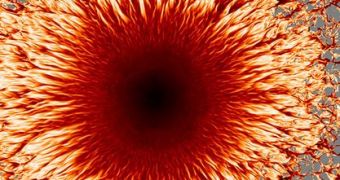Today at the International Astronomical Union Symposium on the Physics of Sun and Star Spots in Ventura, California, Research Professor Jeongwoo Lee from the New Jersey's Science & Technology University will speak about sunspots as a strong radio emissions source and the information that they carry.
Professor Lee will have a lecture about the Owens Valley Solar Array (OVSA), which is one of the two unique frequency-agile radio telescopes in the world.
He will talk about the research opportunities he had at the facility managed and operated by the NJIT since 1997, and about several ideas from his article called “Radio Emissions from Solar Active Regions”, published by Space Science Reviews.
The best example for concrete observational determination of the coronal magnetic field and temperature is at the OVSA, where the imaging spectroscopy (a technique that allows the construction of spectrum in every spatial point of interest) of sunspots is used.
Owens Valley Solar Array has a very strange large number of frequencies (up to 86) in the range of 1-18 GHz, which can bring the gyro-resonant spectrum to the unique sensitivity of coronal magnetic fields.
Lee said that “the solar corona is of tenuous plasma which is generally too faint to be detected by ground-based observations, and sunspots appear to be very bright at centimeter wavelengths because hot electrons (which are millions of degrees) spin in the coronal magnetic field.
“As they gyrate, they produce an efficient radiation called gyro-resonant emission. This emission can serve as an excellent indicator of the magnetic field and temperature in the corona above sunspots,” he added.
“The ability to measure these quantities without the complications arising in other solar radiations is a particular advantage for studying sunspot radio emissions.”
Another subject covered by the professor’s speech will be the Nobeyama Radioheliograph (NoRH), a Japanese solar-dedicated radio heliograph.
This facility is very important as it has a radio radio synoptic map and butterfly diagram built with the eighteen-year measurement of the solar full disk, which provides an important clue to better understand the nature of the solar cycle.
From the lecture will not miss those who contributed to the premier radio array for astronomical observations, who operated from the National Radio Astronomy Observatory known as the "Very Large Array" (VLA).
VLA solar images helped to perform many studies of sunspot physics, thanks to the high-quality imaging at a few wavelengths in the centimeter range, of the facility.
VLA has also allowed findings of inhomogeneous structures of plasma and magnetic fields, and the presence of electric currents and waves in the sunspot corona. “Such an array should feature as many frequencies as Owens Valley Solar Array offers and as high-resolution imaging as the VLA performs,” Lee said.
“It will advance the study of three-dimensional structures of temperature and magnetic fields above sunspots, and it will allow scientists to continue monitoring time-dependent solar radio activity, such as rapid transient heating, sunspot oscillations, and solar cycle dependence of coronal temperature.”

 14 DAY TRIAL //
14 DAY TRIAL //